REVISITING the scene of the very first ForgottenTour in June 1999 FNY turns again to Brooklyn’s Broadway, formerly the main drag in Williamsburg, where the Vanderbilts looked across the river to Manhattan from their mansions, the Pratts heated their homes, and the Havemeyers put sugar in their coffee.
arly maps from the 1820s and 1830s show that in Williamsburg(h) Broadway was originally a part of South 6th and 7th Streets. By the 1870s Broadway had extended northwest from the Bushwick-Bedford Stuyvesant border and assumed the streets’ route. Williamsburg, which originally had an “h” at the end –dropped in 1855– was originally a part of neighboring Bushwick but was incorporated as a village in 1827 and graduated to city status by the 1850s. The first colonial roads through the area followed an Indian trail called Kykuit, or Kickout (“lookout”), which delineated a rough circle that is today’s Division Avenue, Kent Avenue, Metropolitan Avenue and Keap Street. Brooklyn annexed Williamsburg in 1855 and in turn, Brooklyn was itself captured by New York City in 1898.
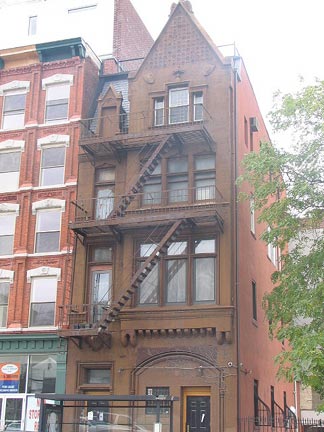

As it has since the 1870s Broadway begins at Kent Avenue and moves, in nearly a straight line, southeast to the junction formed by Fulton Street, Jamaica Avenue and Pennsylvania Avenue on the borders of Bedford-Stuyvesant, Brownsville and Bushwick. Along the way it forms a barrier between Bedford-Stuyvesant and Bushwick and serves as a dividing line in street systems, which is quite clear when consulting a Brooklyn map. While today only the short stretch of Broadway between Kent Avenue and the Williamsburg Bridge plaza is unshrouded by an el — the section we deal with on this page — until the 1930s even this short stretch was denied sunlight as a spur from the el connected to a now-forgotten ferry.
At Broadway and Kent is a wonderfully decorated 4-story peaked brownstone building topped by etched ornamentation and shield containing the date of construction.
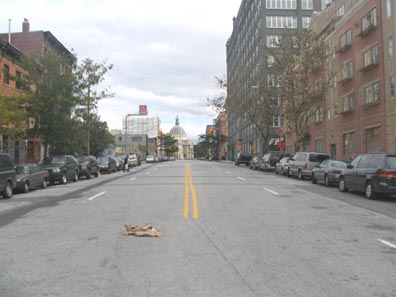
Where it all begins. Every borough has a Broadway (though Manhattan and the Bronx share one) and while Manhattan’s begins at historic Bowling Green, the Cunard building and Trinity Cemetery, in Brooklyn the history is generally more hidden behind the desolation. It’s quiet here on a Sunday afternoon…where is everyone?
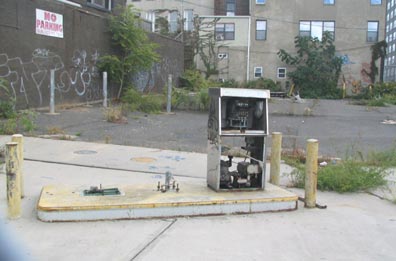
[In 2005 the NE corner of Broadway and Kent featured a trashed gas station, but in 2012 construction cranes were busied here, and Broadway itself had gained a short concrete median.]
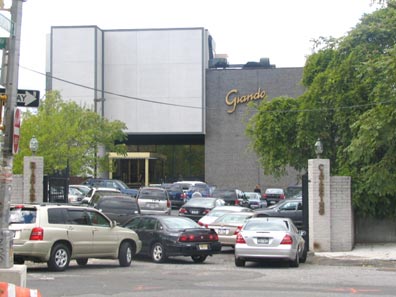
Everyone seems to be at Giando on the Water, which doesn’t seem like a big deal as seen from Kent Avenue but as its website shows, has spectacular views of Manhattan from its East River frontage.

Just as Greenwich Village has Weehawken Street, a tiny one-block thoroughfare a block away from the water, so Williamsburg has a cognate in Dunham Place, named for David Dunham who in 1818 operated a ferry to Manhattan from the nascent settlement. It’s a good bet though that Dunham Place won’t have as many anti-urination signs that Weehawken Street does.
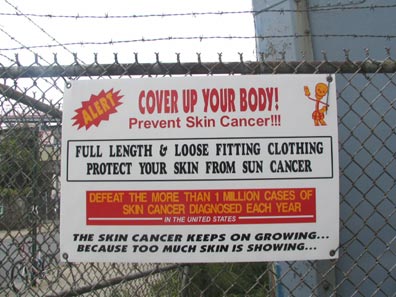
Anyone know the story behind these signs scattered on the streets near the waterfront? Is there a dermatologist needing some work? A worthy admonition, but no organization is shown on any of the signs.
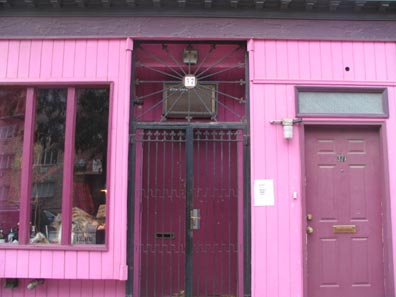
To think I was going to note the pink and purple paint job at 37 Broadway and pass it by. Why, I would have missed…
A seance starring who appears to be…..a relative of Chucky. Plus some decapitated naked cousins of his, a Ouija board, Jack Daniels and Jim Beam. My kinda Halloween party.
According to local legend, 37 Broadway was a stop on the Underground Railroad.
info from Forgotten Fan Caryn Rose
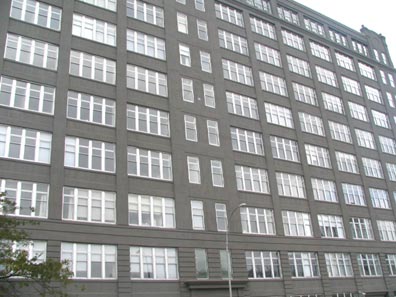
If it’s real star power you want, try the Gretsch Building at Broadway and Wythe Avenue. Both Busta Rhymes and Annabella Sciorra own or have owned apartments here, according to Curbed, though Busta apparently sublets his.
The Gretsch was formerly the main factory and offices of Gretsch Musical Instruments.
The cheapest apartment in the building in 2004 was a one-bedroom selling for about $700K.


A couple of boites have sprung up along Broadway in the area, but the swells might not patronize this one until that rat poison sign is taken down.
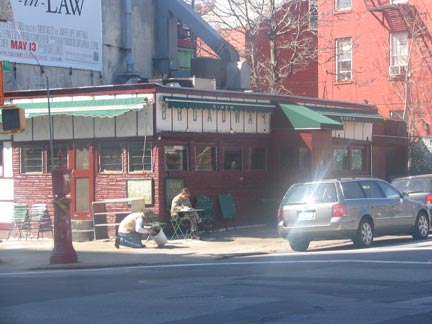
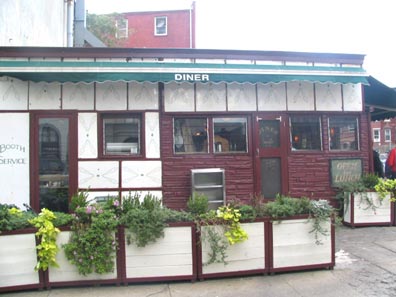
Williamsburg boasts not one but three classic diners from the golden age of the genre, 1920s to the 1950s. This one at Broadway and Berry Street was originally a 1927-vintage hash-slinger. The gimmick here is that the hamburger, on the menu, is called “burger”, the soup is called “soup” and the cereal is called “cereal” with the minimalism extending to the joint’s name, “Broadway Diner.” It’s been generally rated favorably by restaurant critics.
Lower Broadway was, and remains, a manufacturing and wholesaling center for home products, plumbing equipment and paint. These signs could be found, in 2005, in the vicinity of Bedford Avenue.
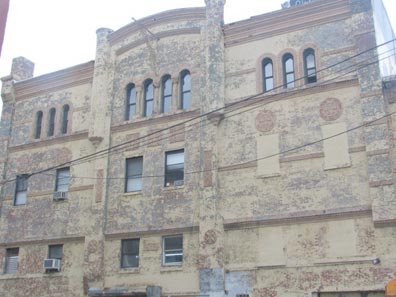
This building on South 6th, just north of its junction with Broadway and Bedford, is the back end of Seaver’s Opera House (which fronted on South 5th). It was built in 1866; it was later known as the Bedford Avenue or Empire Theatre and then a garage. Dancer/actress Louise Carman was a frequent performer at the theatre.
Also: The Bedford Avenue Theatre was constructed in 1891 by [architect W.F. Gaynor]. Its inaugural performance featured the actress Fanny Rice in A Jolly Surprise. The theatre’s tenure as a theatre was cut short – literally – by the construction of the Williamsburg Bridge. The right of way for the bridge, which was opened in 1903, cut off the back half of the theatre, stage and all. The building is listed in the AIA Guide as the Fruitcrest Corporation building, after its most recent industrial tenant. WGPA
It has recently been cleaned up and looks considerably spiffier.
some info provided by Forgotten Fan Steve Woo

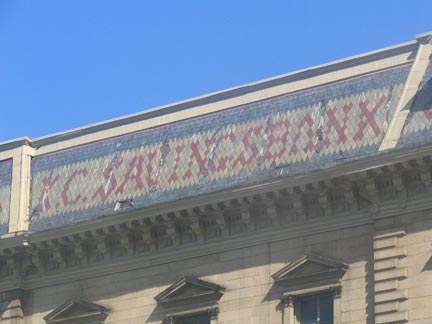
No question what the original purpose of the magnificent building at Bedford and Broadway was–it was originally the Kings County Savings Bank, as was made even clearer when the bank’s name, in terra cotta tile, was uncovered. (The restorers seem to have made an “x” out of he “k” in “bank” though.)
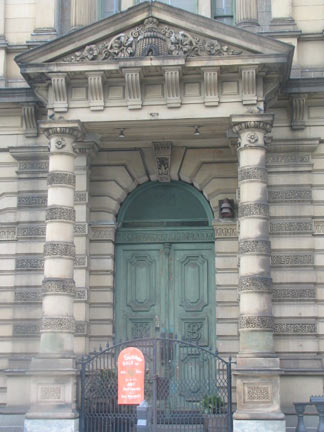
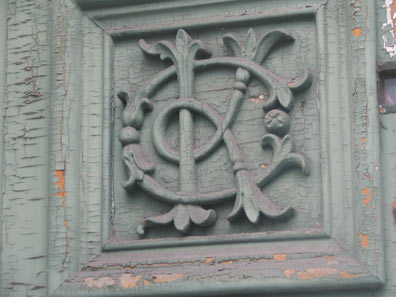
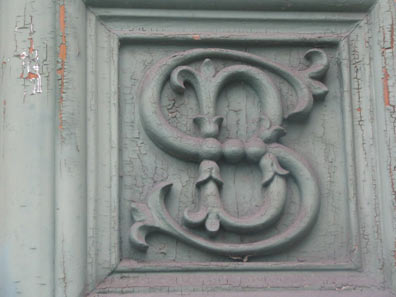
The building’s current tenant, the Williamsburg Art and Historical Center, is restoring the building’s details which include a wigwam over the front door and stylized “KC” and “SB” on the door. Architectural critic Francis Morrone has called the bank “probably the finest Second-Empire-style building in Brooklyn.”
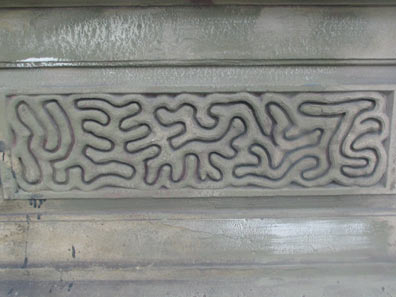

 Most fascinating for your webmaster is the coral-shaped decorative stonework. It also looks like some of Keith Haring‘s work; perhaps he was inspired by the building.
Most fascinating for your webmaster is the coral-shaped decorative stonework. It also looks like some of Keith Haring‘s work; perhaps he was inspired by the building.
The effect is called vermiculation.
image: undersea.com
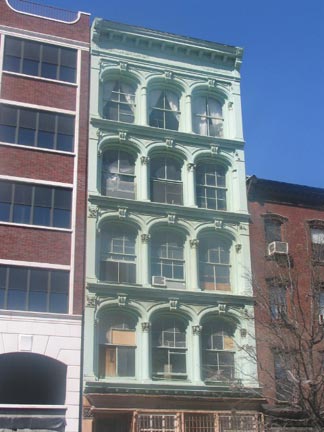
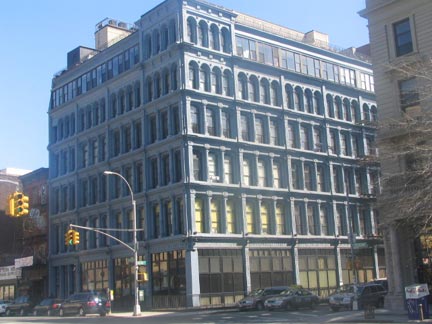
In the Bedford Avenue vicinity Broadway can boast a pair of magnificent cast-iron fronted buildings from the 1870s.
Other than the Capitol dome in Washington, and the gilded dome of the Charles Bulfinch-designed State House in Boston, this may be the most beautiful domed structure in the USA. The Williamsburgh Savings Bank, complete with h, was built by George Post in 1875.
And the fence is no slouch, either.
But does the Singapore-based HSBC have to ruin every building it owns with intrusive signage?
[2012: The offending sign has been removed, as the classic bank has been remodeled into a catering hall]
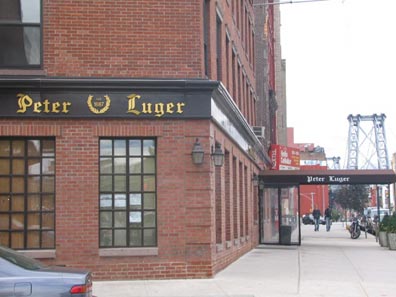
Steak for four ran for about $200 (probably more than that since I last ate there in 2000) at Peter Luger. There’s no credit cards except their own but the cash is worth every bite at NY’s premier steakhouse, which first saw light in 1876, a year after the Williamsburgh Savings Bank opened across the street, as Charles Luger’s Cafe, Billiards and Bowling Alley. It has been a renowned beefeatery since 1887. I have one of their wrapped chocolate coins in my freezer to prove I was there.
Forman 4 Family, an appliance manufacturer from the 30s and 40s, owned this building on Driggs Ave. and Broadway across the street from the Williamsburgh Savings Bank. The building is richly detailed.

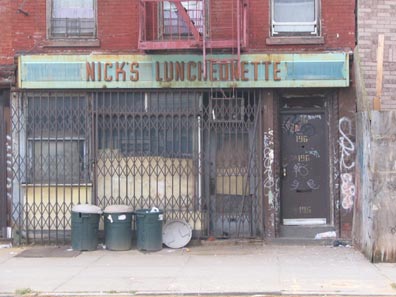
Barbara Corcoran won’t be listing this nondescript new condo and Nick won’t be serving steaks comaparable to Luger (if Nick is still around) but they’re a part of the lower Broadway scene.

In 2005 rock was new to Williamsburg, at least played live. Most notably the Warsaw ( a little further north in Greenpoint) andNorthsix have featured some of the country’s hottest groups. With rock’s disappearance from NYC commercial on-air radio, clubs, Spotify and Ipods are increasingly the way to hear rock & roll in the early 2010s.

Cultures abut each other on west Broadway: the Hasidic Jews from south Williamsburg, the Latinos from north Williamsburg, and the increasing artist demimonde all meet here. Will the conjunction be peaceful, or will there be a war of the worlds with no Tom Cruise or convenient microbes to save the day?*
*that makes sense if you read the H.G. wells book or saw the film.
Pictures for this page were taken in April and October 2005; page was completed November 7, 2005.

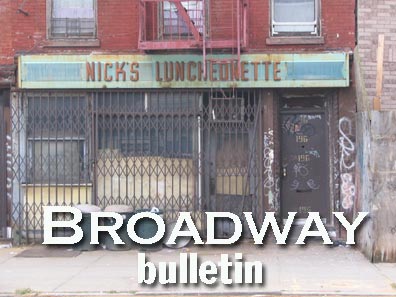
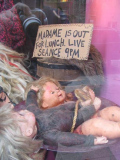
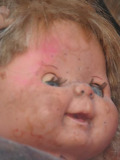
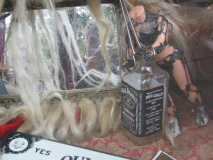

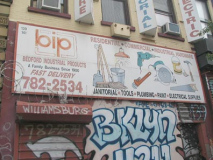
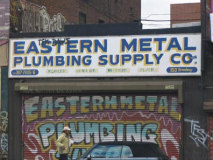
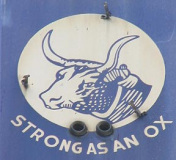

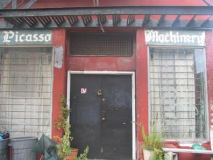
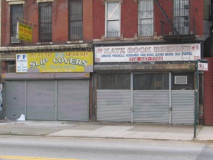
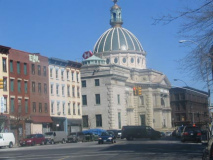
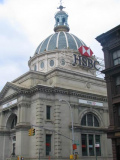
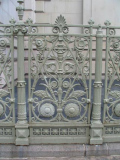
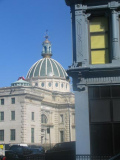
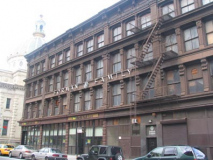
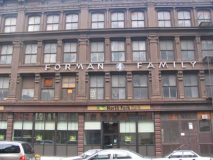
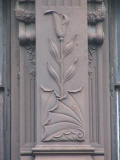
6 comments
The sunburn sign was put up by some Hasids in a futile attempt to get the hipster chicks to coverup and let the the Hasidic males concentrate on their Torah study.
Wow. U covered everything , except Hobart Street, technically in Woodside, but the border of Astoria. I grew up there !!!, 1940’s andb1950′. Need the dedication of the street and the architects. Only the private homes on the western side of Hobart, P.S. 151 on the SW corner!!
Thank u
Just found a business card that has “R.M. Howe’s Son, Furniture. 191, 193 & 195 Broadway, Near Driggs St., Telephone No. 53” This appears to be the Forman 4 Family building. The card was in a George Eliot book published in 1876.
My great-grandfather, Michael Minden, operated a tavern/hotel on the corner of Kent and Broadway, opposite the ferry landing. It was here that he was arrested in November of 1900 for having a casino on the upper floor..
I lived at 152 Broadway ’74 -’82. According to William Rice it had been a sausage factory abandoned in the early ’60s after efforts to unionize. Before that, Rice said, it had been an elegant town house built in the 1860s. When I and two others came the building was quite deteriorated, but we managed to turn our space into great live-in loft studios. Each loft was about 1200 SF and $150/mo. rent. – and illegal!. While fixing it up I noticed hollow sounds behind the plywood front window casings and a door jamb. When I pried off the plywood I pulled out louvered folding shutters with brass fittings and sliding pocket doors with panels of etched glass. The month before we moved in a fly-by-night grocer converted the ground floor into a cheap food emporium, and painted the facade in gaudy red and white with the sign Empire City Foods. I recently saw the building on Google maps and it had a new front, luxury apartments topped off with a penthouse.